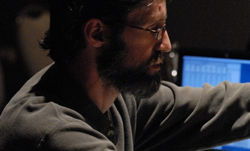[CD]
Katharine Norman — London (1996)
Katharine Norman — London
NMC Recordings [NMC D034], Sonic Arts Network, 1996
Katharine Norman is an internationally recognized composer of music and sound art for instruments and digital resources, frequently inspired by people’s experience of place and landscape. Her publications on sound and art, often literary or experimental in nature, include Sounding Art: Eight literary excursions through electronic music (2004). Her creative writing has featured in various festivals, publications and conferences. She won the 2012 New Media Writing Prize for her interactive “sound essay” Window (for John Cage). Norman received her PhD in composition (computer music) from Princeton. She directed the Electronic Music Studios at Goldsmiths College, London and later headed the studios at City University London. In 2020, she moved to live on an island off the West Coast of BC (Canada); nobody has found her yet. [March 2022]
This CD touches upon the people and moods of London in a trio of digital soundscapes. It also provides a mixed work for clarinet.
The Gulf War gave many post-war adults a slight chill, as war suddenly didn’t seem as distant as before. Katharine Norman’s mother was a youth during World War II and has retained many memories. She shares them with the listener in a quiet, reflective and conversational work.
In Her Own Time (1992) has two characters: Rita Norman and her daughter, the composer. Whose computer music shrouds the atmosphere with a subdued darkness, a softly worded reminder of the lives wasted in war.
When we live in a city for a period of time, a family of reoccurring soundscapes compose our sense of place. In the next work, London E17 (1993), Norman investigates worlds familiar to her day-to-day life as a Londoner. Simple snapshots of anonymous Londoners in anonymous lo-fi settings hang from a melancholic clothesline of Csound tone clusters.
Again, the mood is quiet and reflective. In the work that follows, People Underground (1991), the dark echoes of underground passageways reverberate and rumble in a succession of events that fade in and out of black. The composer demonstrates a purity of purpose here, as all the elements in this work derive from soundscape recordings made in the foot tunnels beneath the Thames.
Rounding off the CD is Trilling Wire (1994), for clarinet and tape. Norman wheels out the computer again and the clarinetist, Jonathan Cooper, comes skipping and dancing along with her. The computer timbres are a kind of stream that the clarinet dashes through — bouncing off one register and then another, and gaining the speed and velocity to soar overhead for a while. The one moment when the computer sounds manage to snare the clarinet, and keep it still for a moment, is the most decisive. After this point, the clarinet drifts back and submerges slowly until the finish.
24 January 1998

Biography
Darren Copeland is a Canadian sound artist who has been active since 1985. His work includes projects exploring multi-channel spatialization for live performance, fixed media composition, soundscape composition, radio art and sound installations. His fixed-media compositions are published by empreintes DIGITALes. Darren Copeland is the Artistic Director of New Adventures in Sound Art (NAISA). http://darrencopeland.net
Social top